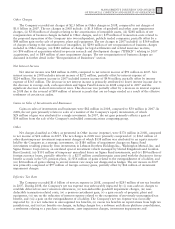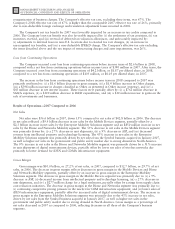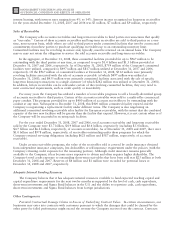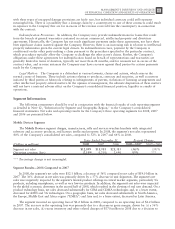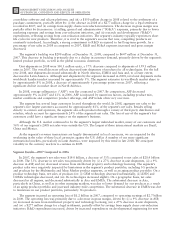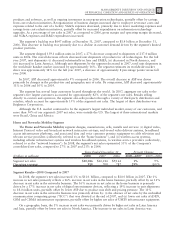Motorola 2008 Annual Report Download - page 61
Download and view the complete annual report
Please find page 61 of the 2008 Motorola annual report below. You can navigate through the pages in the report by either clicking on the pages listed below, or by using the keyword search tool below to find specific information within the annual report.
decrease in accounts receivable in the Mobile Devices segment, primarily related to a significant decrease in net
sales, and decreases in accounts receivable in the Enterprise Mobility Solutions and Home and Network Mobility
segments. The Company’s businesses sell their products in a variety of markets throughout the world and payment
terms can vary by market type and geographic location. Accordingly, the Company’s levels of net accounts
receivable can be impacted by the timing and level of sales that are made by its various businesses and by the
geographic locations in which those sales are made.
In addition, from time to time, the Company elects to sell accounts receivable to third parties. The Company’s
levels of net accounts receivable can be impacted by the timing and amount of such sales, which can vary by
period and can be impacted by numerous factors. Although the Company was not limited in its ability to sell
receivables during 2008, the severe tightening in the credit markets and the ongoing global financial crisis may
limit the Company’s ability to sell receivables in the future, particularly if the creditworthiness of our customers’
declines. As further described under “Sales of Receivables”, subsequent to the end of 2008, one of the Company’s
committed receivables facilities expired and was not renewed.
Inventory: The Company’s net inventory was $2.7 billion at December 31, 2008, compared to $2.8 billion at
December 31, 2007. The decrease in net inventory reflects a decrease in net inventory in the Mobile Devices
segment, partially offset by increases in net inventory in the Enterprise Mobility Solutions and Home and
Networks Mobility segments. Inventory management continues to be an area of focus as the Company balances
the need to maintain strategic inventory levels to ensure competitive delivery performance to its customers against
the risk of inventory excess and obsolescence due to rapidly changing technology and customer spending
requirements.
Accounts Payable: The Company’s accounts payable were $3.2 billion at December 31, 2008, compared to
$4.2 billion at December 31, 2007. The decrease in accounts payable reflects a decrease in accounts payable in the
Mobile Devices segment, partially offset by increases in accounts payable in the Enterprise Mobility Solutions and
Home and Networks Mobility segments. The Company buys products in a variety of markets throughout the
world and payment terms can vary by market type and geographic location. Accordingly, the Company’s levels of
accounts payable can be impacted by the timing and level of purchases made by its various businesses and by the
geographic locations in which those purchases are made.
Reorganization of Businesses: The Company has implemented reorganization of businesses plans. Cash
payments for exit costs and employee separations in connection with a number of these plans were $316 million in
2008, as compared to $281 million in 2007. Of the $250 million reorganization of businesses accrual at
December 31, 2008, $170 million relates to employee separation costs and is expected to be paid in 2009. The
remaining $80 million in accruals relate to lease termination obligations that are expected to be paid over a
number of years.
Benefit Plan Contributions: The Company contributed $243 million to its U.S. pension plans during 2008,
compared to $274 million contributed in 2007. The Company contributed $54 million to its non-U.S. pension
plans during 2008, compared to $135 million contributed in 2007. During 2009, the Company expects to make
cash contributions of approximately $180 million to its U.S. pension plans and approximately $50 million to its
non-U.S. pension plans.
The Company has amended its U.S. pension plans such that: (i) no participant shall accrue any benefits or
additional benefits on or after March 1, 2009, and (ii) no compensation increases earned by a participant on or
after March 1, 2009 shall be used to compute any accrued benefit.
The Company contributed $16 million to its retiree health care plan in 2008, compared to $15 million in
2007, and expects to make no contributions to this plan in 2009. Retirement-related benefits are further discussed
below in the “Significant Accounting Policies—Retirement-Related Benefits” section.
Investing Activities
The most significant components of the Company’s investing activities in 2008 include: (i) net proceeds from
sales of Sigma Fund investments, (ii) capital expenditures, (iii) purchases of short-term investments, (iv) strategic
acquisitions of, or investments in, other companies, and (v) proceeds from the sales of investments and businesses.
Net cash provided by investing activities from continuing operations was $794 million in 2008, compared to
net cash provided of $2.4 billion in 2007 and net cash used of $1.4 billion in 2006. The $1.6 billion decrease in
cash provided by investing activities in 2008 as compared to 2007 was primarily due to: (i) a $6.0 billion decrease
53
MANAGEMENT’S DISCUSSION AND ANALYSIS
OF FINANCIAL CONDITION AND RESULTS OF OPERATIONS




